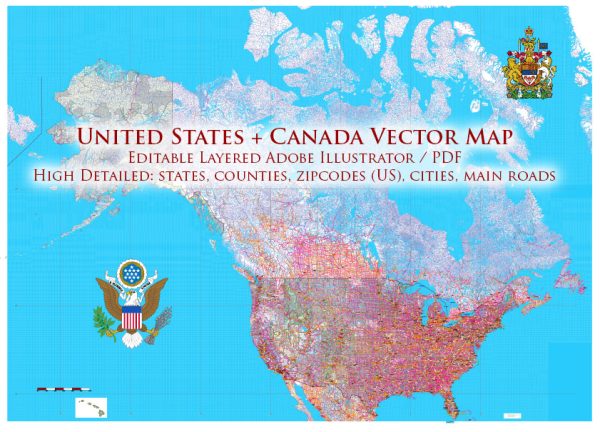The United States and Canada boast diverse and rich biodiversity, encompassing a wide range of ecosystems, species, and habitats. Here’s an overview of the biodiversity in these two North American countries:
United States:
- Terrestrial Biodiversity:
- The U.S. features a variety of terrestrial ecosystems, including forests (coniferous and deciduous), grasslands, deserts, and wetlands.
- Notable fauna includes iconic species like the American bison, black bear, white-tailed deer, and numerous small mammal and bird species.
- The Appalachian Mountains, the Rocky Mountains, and the Sierra Nevada are home to unique flora and fauna.
- Aquatic Biodiversity:
- The U.S. is surrounded by diverse marine environments, including the Atlantic and Pacific Oceans, the Gulf of Mexico, and the Great Lakes.
- Significant marine life includes whales, dolphins, seals, sea lions, and various fish species.
- Freshwater ecosystems, such as rivers and lakes, host a variety of fish, amphibians, and reptiles.
- Biodiversity Hotspots:
- Certain regions are recognized as biodiversity hotspots, such as the Florida Everglades, California Floristic Province, and the Appalachian Highlands.
- The Everglades, for example, is home to unique plant and animal species adapted to its wetland environment.
Canada:
- Terrestrial Biodiversity:
- Canada has vast expanses of forests, including the boreal forest, temperate rainforests on the Pacific coast, and the iconic Canadian Rocky Mountains.
- Notable wildlife includes the grizzly bear, moose, caribou, and the elusive Canadian lynx.
- The Arctic tundra in the north is home to polar bears, Arctic foxes, and a variety of migratory birds.
- Aquatic Biodiversity:
- Canada has the longest coastline in the world, providing diverse marine ecosystems. The Atlantic and Pacific Oceans, as well as the Arctic Ocean, contribute to this richness.
- The country’s freshwater ecosystems, such as the Great Lakes and numerous rivers, support diverse fish species, including salmon and trout.
- Biodiversity Hotspots:
- Canada is known for its unique biodiversity hotspots, such as the Haida Gwaii archipelago off the coast of British Columbia and the Gaspé Peninsula in Quebec.
- These areas support a high level of endemism, with species found nowhere else in the world.
Conservation Challenges and Efforts:
- Habitat Loss: Both countries face challenges related to habitat loss due to urbanization, agriculture, and resource extraction. Conservation efforts aim to protect and restore critical habitats.
- Climate Change: Climate change poses a threat to biodiversity by altering ecosystems and impacting the distribution of species. Conservation initiatives focus on mitigating climate change effects and promoting adaptation.
- Protected Areas: Both the U.S. and Canada have established national parks, wildlife reserves, and protected areas to conserve biodiversity. These areas provide essential habitats for many species.
- Collaboration: Transboundary conservation initiatives involve cooperation between the U.S. and Canada to address shared biodiversity concerns, particularly along their extensive border.
Despite facing conservation challenges, the U.S. and Canada remain committed to preserving their rich biodiversity through a combination of conservation policies, scientific research, and public engagement.


 Author: Kirill Shrayber, Ph.D.
Author: Kirill Shrayber, Ph.D.